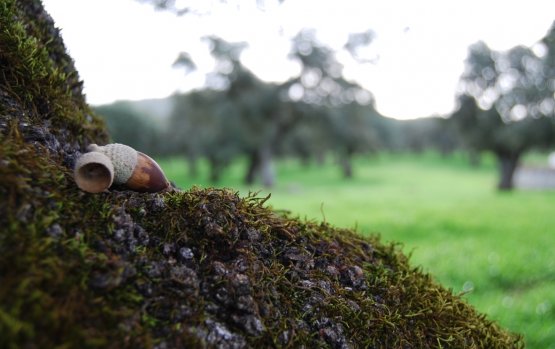Extremadura is not just the largest autonomous community in Spain. It is also the region in this country that dedicates the largest space to the essential element for the production of Jamón Ibérico, namely the Dehesa. This term is almost impossible to translate, yet it is crucial to understand the main secret of the most delicious ham in the world, that is to say the diet of Iberian pigs before they are slaughtered.
In Extremadura over one million hectares of land are dedicated to the Dehesa, which we can say is the result of human selection applied to the nature of these lands (someone in Spain defines it as "el bosque humanizado"). Originally, these were woodlands, which for various reasons were not very suitable for cultivation and agriculture, but could well be used as pastures. Also thanks to the presence of trees from the Quercus species, which produce a fruit rich in sugars, full of taste and nutrients: acorn ("bellota" in Spanish).

Bellota: for three months, it is the essential food for the cerdo ibérico that can then be used for a ham certified as puro de bellota
Initially, acorns were used in various ways, including as animal feed, until it was understood that one animal in particular, Iberian pig that is, improved sensibly its meat thanks to a diet based on acorns.
Dehesa is thus born as the result of a selective deforestation made by man, who thus modelled a unique ecosystem, on top of a fascinating landscape made of green fields and acorn trees (in particular, holly oaks, cork oaks and Portuguese oaks) in which the pigs can graze so they can feed exclusively on grass and "bellotas".
This doesn’t happen throughout the life of the animal, but only during the last months of its existence. Indeed, the pig’s fat is completely renewed in the space of around three months: before slaughtering, it is thus essential for the pig to eat only acorns, so that it can renew its fat in this way. And it is not just a question of good flavour, as the large quantity of oleic acid in the acorns gives a high level of unsaturated acid fats, the famous “good fats”, to this meat. The season in which pigs are brought to the
Dehesa is called "montanera" and begins early in November, when the acorns fall, and then continues at least until the end of January.
The other essential element for an excellent
Jamón is the physical exercise a pig needs to do in order to find the acorns, which he loves, thanks to the wide spaces available. This physical exercise makes the muscles of the animals more robust and most of all facilitates the well-aspired infiltration of fat in the meat.
Visiting the
Dehesa in Extremadura means crossing inspiring and very scenic landscapes: the province of Badajoz, in particular, is the most suitable one in order to cover a part of the
Ruta del Jamón Ibérico, and also offers the possibility to visit the
Museo del Jamón in Monesterio, with a modern and effective set-up that allows to get a deeper knowledge of this extraordinary Iberian treasure within a short visit.
1. To be continued